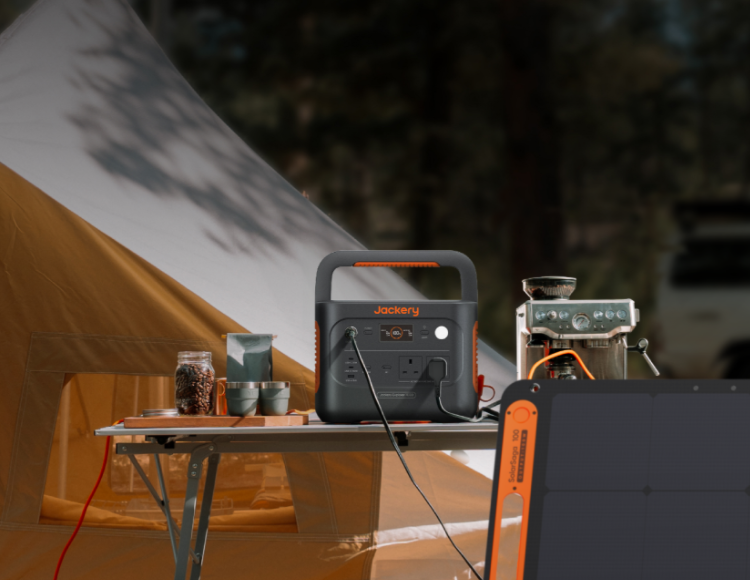It is not surprising that millions of tourists visit Scotland every year to walk because of its well-known breathtaking peaks, expansive glens, and lengthy paths. According to a recent study, this little region in the north is among the best places in the world for hiking.
This guide will assist you in making thoughtful plans for hiking in Scotland so that you make the most of your stay, whether you're visiting the UK from abroad or are a resident already and want to venture a little off the usual path.
Furthermore, a reliable power supply, like Jackery Portable Power Stations, can charge your essential electronics during hiking or backpacking, especially for some overnight hikes.
|
Key Takeaways: |
|
Some popular trails include Ben Nevis, the West Highland Way, and the Old Man of Storr, each offering unique challenges and stunning views. Always carry a map, compass, and sufficient food and water, especially in remote areas. To protect the paths' original condition and the beauty of nature, please practise Leave No Trace ethics. Be prepared for midges in summer; use repellents and avoid hiking at dawn and dusk. We highly recommend Jackery Explorer 100 Plus and 300 Plus charging devices for your hiking trip. You should research your chosen routes and their difficulty to ensure a safe and enjoyable hiking experience. |
Is Scotland Good for Hiking?
Scotland is a great place to go hiking, or as we call it, hillwalking. Scotland has no fewer than 282 Munros, mountains over 3,000 feet tall; 221 Corbetts, or mountains between 2,500 and 3,000 feet; and 219 Grahams, or mountains between 2,000 and 2,500 feet above sea level.
Despite its small size - you can cross it in less than an hour in some places - between its three major mountain ranges. Therefore, if mountains are your thing, Scotland has enough to offer.
In addition, there are more than 6,000 miles of coastline to explore on foot and several dozen long-distance walking routes, including the West Highland Way, the John Muir Way, and the Cape Wrath Trail.
Cultural Experiences
- Historic Trails: Walk along the Jacobite Trail, which links historical monuments and battlegrounds by following the path taken during the Jacobite Risings.
- Visit Local Festivals: There are festivals, such as the Skye Festival or the Hebridean Celtic Festival, which frequently include hiking-related events and get-togethers with the community.
Unique Hiking Experiences
- Discover The Bothy System: This system allows hikers to locate log cabins in isolated locations for an evening stay, encouraging a spirit of adventure.
- Nature Reserves: Take a trip to locations like the Trossachs Nature Reserve and Loch Lomond, managed by the RSPB, to observe animals on well-kept pathways.
Best Time for Hiking in Scotland
With an average of about 100mm each month, December, January, and February are usually the wettest months in Scotland. With an average of about 60mm each month, June, July, and August are typically the driest months.
Regional variations exist, too, with Scotland's hilly parts often receiving more rainfall than its coastal and low-lying areas. Scotland's highlands are renowned for their regular rains, particularly during the summer.
There are a few things to consider when deciding the ideal time to walk in Scotland. Scotland has pleasant weather all year round, with typical highs between 8 to 17C (46 and 63F).
Summers, which run from May to August, are often hot and humid, with very few days above 20C (68F). Winters, which run from November through February, are often damp and chilly, with an average temperature of 4C (39F). It usually snows in the mountains.
Consideration should be given to the local weather while organising a hike in Scotland. Although Scotland has a generally warm temperature, local weather forecasts should be checked before departure as rainfall varies significantly between regions. By doing this, you can ensure you are ready and adjust your route appropriately.
Overall, April through October are ideal for walking in Scotland because of the warmer weather and less precipitation. With its cool climate and the addition of breathtaking autumn foliage, September is a great time to come.
What to Pack for Hiking in Scotland
This comprehensive packing list for hiking in Scotland covers all the essentials for an enjoyable and safe hike throughout the country's trails, from head to toe. Each item's precise brand or kind will rely on your preferences.

One-Day Hiking Essentials
Day hikes can be completed in a single day instead of multi-day trips such as backpacking or full-throttle hikes. To prevent forgetting essentials, it is recommended to use a helpful checklist when packing for a day hike.
|
One-Day Hiking Essentials |
||
|
Hiking Bag |
Food |
First Aid Kit |
|
Gym Clothes |
Drinking Water |
Multi-Tool |
|
Hiking Shoes |
Navigation Tools |
Portable Power Supply |
Multi-Day Hiking Essentials
It is imperative to bring all necessary items, as multi-day treks may extend for several days without a return. In addition to preparing your hiking gear, it is essential to consider your camping gear. The following is a comprehensive inventory of the necessary items to prepare for a multi-day walk. The basic equipment for hiking in Scotland is as follows:
|
Multi-Day Hiking Essentials |
||
|
Backpack |
Hiking Boots |
Socks |
|
Shorts |
Layers |
Hat |
|
Sunglasses |
Food |
Water |
|
GPS Navigator |
Pocket Knife |
Headlamp |
|
First Aid Kit |
Bug Spray |
Matches |
|
Multi-Tool |
Ten Essentials |
Jackery Portable Power Station |
Many first-time overnight hikers always forget to take a power supply to charge specific essential devices, such as GPS devices, phones, radios, etc. Jackery Portable Power Stations can make hiking more fun and powerful since electricity is vital, especially for overnight hiking.
Bring a small power station like the Jackery Explorer 100 Plus or Explorer 300 Plus to charge your electronics on your hiking trip. They are only the size of a basketball or a book, so you can easily take them everywhere.
Best 10 Hikes in Scotland
Scotland has many attractions, but some of its most incredible beauties are on the city's outskirts, mountains, coast, and forests. So whether you're looking for a great waterfall or fantastic mountain views, hiking is a great way to do it.

1. Ben Nevis by The Mountain Path
Location: Fort William PH33 6TE, United Kingdom (Open in Google Maps)
Website: Ben Nevis by The Mountain Path
Length: 17km
Difficulty: Hard
Hiking Time: 7-9 Hours
The tallest peak in Britain is called Ben Nevis. This path is the usual ascent of the mountain; it's easy, albeit challenging, by hillwalking standards, so those with less expertise should read all the warnings.
The road may get crowded, especially during the summer and on holidays. However, Ben Nevis weather may change quickly, so it's essential to be prepared for navigation while the mist is low and suitably outfitted.
2. Old Man of Storr
Location: Portree IV51 9HX, United Kingdom (Open in Google Maps)
Website: Old Man of Storr
Length: 3.8km
Difficulty: Easy
Hiking Time: 1 Hour 15 Min
The Isle of Skye's most well-known trek and unquestionably busiest attraction is the Old Man of Storr on the Trotternish Ridge. Previously, the walk's initial section was through harvested pine woods that were farmed. Most of the walk follows a smooth, well-maintained trail that ascends to the overlooks.
A handful of the gates are double-height to keep deer out. As you enter each gate, close it. Take time to go through the Walk Slide Show, which describes what to expect.
3. Arthur's Seat
Location: Edinburgh EH15 3PY, United Kingdom (Open in Google Maps)
Website: Arthur's Seat
Length: 4.3km
Difficulty: Moderate
Hiking Time: 1-2 Hours
Approximately 2,000 years ago, there were four hill forts, including Arthur's Seat. In addition to its rich historical legacy, Holyrood Park provides walking trails, peace, wildlife, volcanic geology, and unmatched city views from various viewpoints. The park's remarkable diversity of grassland ecosystems and its globally significant volcanic geology have earned it multiple designations as Sites of Special Scientific Interest (SSSI).
4. The Quiraing Circuit
Location: Portree, Sartle, Staffin, Portree IV51 9LB, United Kingdom (Open in Google Maps)
Website: The Quiraing Circuit
Length: 6.8km
Difficulty: Hard
Hiking Time: 3-4 Hours
The Wilderness Coast Walk is over 100km from Sydenham Inlet in Croajingolong to Wonboyn in New South Wales. You will hike along the rugged coastline, explore secluded beaches, dunes and vast estuaries, walk along long stretches of sand and hike through lush vegetation on ill-defined trails.
This hike is ideal for experienced hikers. Please note that campsites on this hike must be reserved. Additionally, minimal-impact bushwalking is highly encouraged, especially within the Krajin Gurung National Park, as the area has been declared a wilderness area.
5. Fairy Pools
Location: Isle of Skye IV47 8TA, United Kingdom (Open in Google Maps)
Website: Fairy Pools
Length: 4.2km
Difficulty: Easy
Hiking Time: 1 Hour 17 Min
The breathtaking Fairy Pools are in Glenbrittle, Isle of Skye, and are open for free admission at any time of day. Overlooking Glenbrittle are the magnificent Cuillin mountains. The Cuillin has several tributaries.
One is the river with waterfalls known as the Fairy Pools, a well-liked walking destination. Beautiful rock pools filled with spring water from the mountains, such as the Fairy Pools, are supplied by many waterfalls. Visitors may walk the breathtaking 2.4 kilometres from the parking lot to the Fairy Pools over a trail with bridges.

6. Coire Gabhail
Location: Ballachulish PH49 4HX, UK (Open in Google Maps)
Website: Coire Gabhail
Length: 6.3km
Difficulty: Moderate
Hiking Time: 2 Hours 30 Min
It is often regarded as a challenging course that averages two hours and fifteen minutes. Since this location is well-liked for walking, jogging, and hiking, you'll meet other visitors while exploring. March through October is when this walk is most enjoyable. Dogs are allowed; however, they have to be leashed.
7. Cape Wrath Trail
Location: Achnasheen IV22 2PA, UK (Open in Google Maps)
Website: Cape Wrath Trail
Length: 370km
Difficulty: Hardest
Hiking Time: 3 Weeks
The Cape Wrath Trail is an unofficial, unmarked, and remarkably untamed long-distance path extending from Fort William to Cape Wrath, the northwesternmost point of mainland Scotland. An exceptional and demanding path for seasoned long-distance trekkers, the trail traverses some of Scotland's most breathtaking terrains.
The Cape Wrath Trail is an entirely unmarked path that traverses predominantly wild and mountainous terrain for a significant portion of its length. The walking has less resemblance to established, defined trails like the West Highland Way.
8. Conic Hill
Location: Stirling G63 0AG, United Kingdom (Open in Google Maps)
Website: Conic Hill
Length: 4.5km
Difficulty: Moderate
Hiking Time: 2-3 Hours
It is often regarded as a challenging course that averages two hours and fifteen minutes. Since this location is well-liked for walking, jogging, and hiking, you'll probably meet other visitors while exploring. March through October is when this walk is most enjoyable. Dogs are allowed; however, they have to be leashed.
9. John Muir Way
Location: North Berwick, UK (Open in Google Maps)
Website: John Muir Way
Length: 215km
Difficulty: Hard
Hiking Time: 4-5 Days
The John Muir Way, one of Scotland's Great Trails, guides Scotland's landscapes, history, and heritage. It traverses central Scotland, connecting Helensburgh in the west and John Muir's birthplace, Dunbar, in the east. You can conquer the 134-mile adventure in one go or divide it into shorter sections. The trail is fully marked for walking and cycling.
10. West Highland Way
Location: Crianlarich, UK (Open in Google Maps)
Website: West Highland Way
Length: 154km
Difficulty: Hard
Hiking Time: 6-7 Days
The West Highland Way offers a glimpse of otherworldly beauty, with wildflower-filled glens and rugged undulating landscapes resembling fairytale scenes. Beginning in the community of Milngavie, this long-distance trek spans 154 kilometres to Fort William, the outdoor capital of the United Kingdom.
Since this location is well-liked for camping, hiking, and birdwatching, you will probably run into other visitors while exploring. March through October is when this walk is most enjoyable. Dogs are allowed to run off leashes in some locations.
Jackery Portable Power Stations for Hiking
Take your Scotland hiking adventures to the next level with Jackery Portable Power Stations. Jackery Portable Power Stations are made for people who like being outside and care about the environment and their comfort. They give your tools a safe way to get power while on the go.

Jackery has been a pioneer in the industry, recognising that mobile lifestyles necessitated outdoor portable power stations to ensure that you could continue operating even when disconnected from the grid. The best way to meet your growing power demand outdoors is through Jackery's innovation and improved technology.
These generators can use the sun's energy now that Jackery Solar Panels are added. This makes them an eco-friendly power source for Victoria's beautiful scenery. We recommend Jackery Explorer 100 Plus and 300 Plus for hiking trips since they are compact, portable, and powerful.
|
Product |
Jackery Explorer 100 Plus |
Jackery Explorer 300 Plus |
|
Capacity |
99.2 Wh / 31000 mAh 3.2V |
288Wh |
|
Life Cycle |
2000 Cycles, Up to 80%+ Capacity |
1500 cycles to 80%+ capacity |
|
Battery Cell |
LiFePO4 battery |
LiFePO4 battery |
|
Dimension |
3.43x3.41x4.96 in |
6.6x6.1x9.1 in |
|
Recharging Methods |
Explorer 100 Plus + 1*SolarSaga 100W: 2H; USB-C Charging: 4H; Car Charging: 2.5H |
Explorer 300 Plus + 1*SolarSaga 200W: 4H; USB-C Charging: 4H; Car Charging: 5.5H; Wall Charging: 2H |
|
Output Ports |
1*USB-A: 18W Max, 5V⎓3A, 9V⎓2A, 12V⎓1.5A; 2*USB-C: 100W Max, 4.5V⎓5A, 5V⎓3A, 5V⎓4.5A, 9V⎓3A, 12V⎓3A, 15V⎓3A, 20V⎓5A 1*USB-C PD: 100W Max, 5V⎓3A, 9V⎓3A, 12V⎓3A, 15V⎓3A, 20V⎓5A |
1*AC Output: 230V~50Hz,1.31A, 300W Rated, 600W Max; 1*USB-A: 15W Max. 5V⎓3A; 2*USB-C: 100W Max,5V⎓3A, 9V⎓3A, 12V⎓3A, 15V⎓3A, 20V⎓5A; 1*Carport: 12V⎓10A |
Jackery Explorer 100 Plus
The Jackery Explorer 100 Plus has a LiFePO4 battery that endures 2,000 cycles while maintaining 80% of its capacity. Weighing only 965 grammes, it offers portable power conveniently within your grasp, making it ideal for hiking.
MPPT technology guarantees 99% efficiency in solar charging. A complete DC input requires 1.8 hours, whereas solar charging with a single SolarSaga 100W Solar Panel necessitates 2 hours. Jackery provides comprehensive solutions for all scenarios, including automobile charging, various alternative charging ways, and during power outages.
It includes a complete set of protective features, such as low-temperature protection, over-temperature protection, short circuit protection, over-current protection, over-voltage protection, and a low-voltage warning system to guarantee reliable and safe operation. It is suitable for outdoor activities, particularly trekking.

Jackery Explorer 300 Plus
The Jackery Explorer 300 Plus portable power station is a lightweight and efficient power source that fulfils energy requirements for diverse scenarios, including hiking, biking, camping, RVing, and emergency power backup.
This power station features a distinctive Battery Management System (BMS). The gadget incorporates 52 safety measures and 12 BMS algorithms that collaboratively provide the utmost safety for both the device and any connected appliances. It includes four types of physical security to guarantee the safety of all individuals.
This model is distinguished by its sophisticated app control feature, enabling users to manage the battery efficiently via Wi-Fi or Bluetooth. This renders it more contemporary and user-friendly. Weighing merely 8.27 pounds, it is an exceptional option for individuals frequently on the go.

Tips for Hiking in Scotland
It's easy to overlook how difficult trekking may be in Scotland. Our best advice for hiking in Scotland's Highlands is provided here.
Even if these mountains are not as massive as Everest or the 4000m summits of the Alps, they are nonetheless mountains. In geological history, all that is left of the 7000-meter summits are their roots; nevertheless, they provide a formidable obstacle and breathtaking views that may equal those seen elsewhere.
Don't Underestimate The Mountains
Ben Nevis, the tallest peak in Scotland, is just 1309 meters above sea level, yet the path begins at sea level and climbs to the top.
A 1000-meter elevation climb or trek is considered a rather strenuous day's work by most; hence, it should only be done by those who are well-prepared for a mountain day, with over-the-ankle walking boots, additional layers of clothing, waterproofs, food, water, a map and a compass.
Build Your Stamina
Scotland's mountain days might require lengthy treks that take eight hours or longer to complete. The Scot Mountain Holidays-operated Cairngorm 4000ers tour entails a single-day excursion during which mountain bikes are used to reach the mountain's foot, providing a slim opportunity to return before evening.
Consequently, to maximise your time throughout the challenge, you'll need to get ready by increasing your exercise routine to increase your stamina. Since most challenges will take more than one day to complete, you must commit to your exercise routine throughout many days of the week.
|
Tips for Training Your Stamina |
|
Seek opportunities to walk to work, disembark from the bus or train early, or walk a portion of the way. Work in a cycle if possible. A little early nighttime sleep will allow you extra morning time to work out before work. Although preparing for a mountain challenge differs from training for a triathlon, planning is still essential for a successful challenge. Use the treadmill on the most significant gradient in the gym. The treadmill's built-in computers indicate that it prepares you well for your mountain endeavour and burns calories at the fastest pace possible. |
Midge Repellent
Midges annoy hikers in windless weather; they come in large numbers in the summer. The Scottish Highlands are home to the so-called "highland midges," which are tiny, bothersome, and capable of leaving behind uncomfortable, itchy bites. Therefore, carry insect repellent and cover up any exposed skin as much as possible.
It is advisable to smoke an incense stick during breaks and to use a head net for protection in extreme situations. If not, you must consume food while strolling through more tranquil places. Any breeze will carry the tormentors away, and movement helps to shake them off. Hiking should be avoided during dawn and dusk since they are also worthwhile at these times.
Hiking in Scotland FAQs
The following are the frequently asked questions about hiking in Scotland:
- What is the number 1 thing to see in Scotland?
Scotland's iconic Edinburgh Castle has dominated the capital's skyline for centuries. It's situated unusually on a dormant volcano. It claims to be the top spot as Scotland's most popular paid attraction. Similar locations to investigate are Falkland Palace, Linlithgow Palace, and Stirling Castle.
- Does Scotland have good hiking?
Whether you're an expert hiker or a beginner, Scotland's long-distance walking routes, such as the Great Glen Way and the West Highland Way, are among the top hiking paths.
- Is it safe to hike alone in Scotland?
Indeed. It's pretty secure. However, if you're trekking in a rural region or the mountains, you must ensure you have the right equipment. Individuals lose their lives hiking in the hills yearly due to inclement weather and inadequate clothes or equipment.
Final Thoughts
In conclusion, with its varied paths and stunning scenery, hiking in Scotland provides an unmatched experience for both experienced and inexperienced travellers. Everyone has something to discover, from the majestic shoreline to the majestic Munros.
You can guarantee an unforgettable trip across Scotland's breathtaking environment by making cautious plans and bringing the appropriate equipment. So grab a pair of boots, embrace the journey, and explore the stunning beauty of Scotland's trails!






























































































